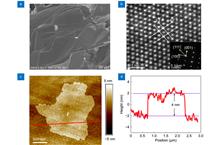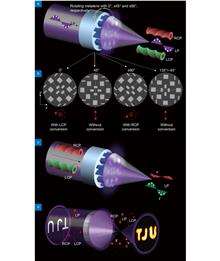 View fulltext
View fulltext
The Kerr nonlinearity in two-dimensional (2D) nanomaterials is emerging as an appealing and intriguing research area due to their prominent light processing, modulation, and manipulation abilities. In this contribution, 2D black arsenic-phosphorus (B-AsP) nanosheets (NSs) were applied in nonlinear photonic devices based on spatial self-phase modulation (SSPM) method. By applying the Kerr nonlinearity in 2D B-AsP, an all-optical phase-modulated system is proposed to realize the functions of “on” and “off” in all-optical switching. By using the same all-optical phase-modulated system, another optical logic gate is proposed, and the logical “or” function is obtained based on the 2D B-AsP NSs dispersions. Moreover, by using the SSPM method, a 2D B-AsP/SnS2 hybrid structure is fabricated, and the result illustrates that the hybrid structure possesses the ability of the unidirectional nonlinear excitation, which helps in obtaining the function of spatial asymmetric light propagation. This function is considered an important prerequisite for the realization of diode functionalization, which is believed to be a factor in important basis for the design of isolators as well. The initial investigations indicate that 2D B-AsP is applicable for designing optical logical devices, which can be considered as an important development in all-optical information processing.
All-inorganic CsPbBr3 perovskite quantum dots (QDs) have received great attention in white light emission because of their outstanding properties. However, their practical application is hindered by poor stability. Herein, we propose a simple strategy to synthesize excellent stability and efficient emission of CsPbBr3 QDs by using 2-hexyldecanoic acid (DA) as a ligand to replace the regular oleic acid (OA) ligand. Thanks to the strong binding energy between DA ligand and QDs, the modified QDs not only show a high photoluminescence quantum yield (PLQY) of 96% but also exhibit high stability against ethanol and water. Thereby warm white light-emitting diodes (WLEDs) are constructed by combining ligand modified CsPbBr3 QDs with red AgInZnS QDs on blue emitting InGaN chips, exhibiting a color rendering index of 93, a power efficiency of 64.8 lm/W, a CIE coordinate of (0.44, 0.42) and correlated color temperature value of 3018 K. In addition, WLEDs based on ligand modified CsPbBr3 QDs also exhibit better thermal performance than that of WLEDs based on the regular CsPbBr3 QDs. The combination of improved efficiency and better thermal stability with high color quality indicates that the modified CsPbBr3 QDs are ideal for WLEDs application.
The optical nonlinearity in polycrystalline zinc selenide (ZnSe), excited with 775 nm, 1 kHz femtosecond laser pulses was investigated via the nonlinear transmission with material thickness and the Z scan technique. The measured two photon absorption coefficient β was intensity dependent, inferring that reverse saturated absorption (RSA) is also relevant during high intensity excitation in ZnSe. At low peak intensity I –2, we find β = 3.5 cm GW–1 at 775 nm. The spectral properties of the broad blueish two-photon induced fluorescence (460 nm-500 nm) was studied, displaying self-absorption near the band edge while the upper state lifetime was measured to be τe ~ 3.3 ns. Stimulated emission was observed when pumping a 0.5 mm thick polycrystalline ZnSe sample within an optical cavity, confirmed by significant line narrowing from Δλ = 11 nm (cavity blocked) to Δλ = 2.8 nm at peak wavelength λp = 475 nm while the upper state lifetime also decreased. These results suggest that with more optimum pumping conditions and crystal cooling, polycrystalline ZnSe might reach lasing threshold via two-photon pumping at λ = 775 nm.
If a metalens integrates the circular polarization (CP) conversion function, the focusing lens together with circular-polarizing lens (CPL) in traditional cameras may be replaced by a metalens. However, in terahertz (THz) band, the reported metalenses still do not obtain the perfect and strict single-handed CP, because they were constructed via Pancharatnam-Berry phase so that CP conversion contained both left-handed CP (LCP) and right-handed CP (RCP) components. In this paper, a silicon based THz metalens is constructed using dynamic phase to obtain single-handed CP conversion. Also, we can rotate the whole metalens at a certain angle to control the conversion of multi-polarization states, which can simply manipulate the focusing for incident linear polarization (LP) THz wave in three polarization conversion states, including LP without conversion, LCP and RCP. Moreover, the polarization conversion behavior is reversible, that is, the THz metalens can convert not only the LP into arbitrary single-handed CP, but also the LCP and RCP into two perpendicular LP, respectively. The metalens is expected to be used in advanced THz camera, as a great candidate for traditional CPL and focusing lens group, and also shows potential application in polarization imaging with discriminating LCP and RCP.












